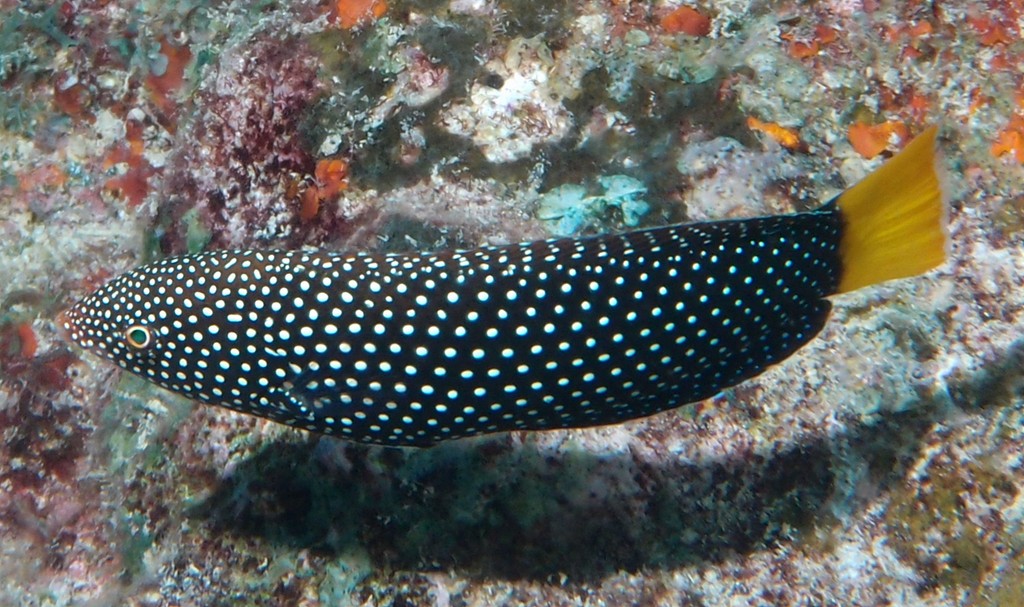ANAMPSES MELEAGRIDES - (VALENCIENNES, 1840)
Actinopterygii (Gigaclass) > Actinopteri (Class) > Teleostei (Subclass) > Labriformes (Order) > Labroidei (Suborder) > Labridae (Family) > Anampses (Genus)
Labre à queue jaune, Labre pintade, Speckled wrasse, Dotted wrasse, Spotted wrasse, Yellowtail wrasse, Yellow-tail tamarin, Geelstert-tamarin, Gelbschwanz-Junker, Hokutobera, ホクトベラ, 北斗阿南魚, 黄尾阿南鱼,
Synonymes
Anampses amboinensis Bleeker, 1857
Anampses ikedai Tanaka, 1908
Anampses lunatus Sauvage, 1891
Anampses meleagris Günther, 1862
Anampses nagayoi Tanaka, 1908
-----------------------------
Description
Dorsal spines (total): 9; Dorsal soft rays (total): 11-13 (usually: 12); Anal spines: 3; Anal soft rays: 11-13 (usually: 12); Lateral line scales: 26; Gill rakers: 18-20; Body depth: 3.1-3.4 in SL; Caudal fin of adults truncate to emarginate; Rounded in small juveniles; Pelvic fins rays: 1.5-2.0 in HL. Body slightly to moderately deep, compressed. Mouth small, terminal; Lips moderately fleshy. A single pair of incisiform forward-projecting teeth at front of each jaw; Remaining teeth in jaws minute or imperceptible; No teeth at corner of mouth or on roof of mouth. Head scaleless. Max. length: 22.0 cm TL. Depth range: 3 - 60 m, usually 5 - 30 m.
Color
Etymology
Anampses: from Greek verb, anakampto = to reflect, bend back. Hence, to bend back one's course, return. Refer to the peculiar shape of the four anterior teeth.
meleagrides: from Latin, meleagris = guinea fowl + from Latin suffix, -(o)ides = having the form of. In Greek mythology, the Meleagrids were the daughters of Althaea and Oeneus, sisters of Meleager. When their brother died, they cried incessantly until Artemis changed them into guineafowl and transferred them to the island of Leros.
Original description: Anampses meleagrides Valenciennes, 1840 - Type locality: Mauritius, Mascarenes, southwestern Indian Ocean.
Distribution
Red Sea; Indo-West Pacific: KwaZulu-Natal (South Africa), East Africa, Socotra (Yemen), Seychelles, Madagascar and Mascarenes (La Réunion, Mauritius, Rodrigues), east to Samoa and Tuamotu Archipelago (French Polynesia), north to southern Japan and Ogasawara Islands (Japan), south to Australia, Lord Howe Island (Australia) and New Caledonia.
Biology
Adults are found in areas of mixed coral, rubble, consolidated limestone, and sand of seaward reefs; Also in soft coral or sponge habitats. Oviparous, distinct pairing during breeding. Aquarium fish
Similar species
Anampses geographicus (Valenciennes, 1840) - Reported from New Caledonia - Link to the species (here). Underwater, Anampses meleagrides is easily confused with male Anampses geographicus, unless Anampses meleagrides is displaying the iridescent blue-green lines and spots over the body and fins.
Anampses lineatus (Randall, 1972) - Reported Red Sea; Indian Ocean: KwaZulu-Natal (South Africa), East Africa, Socotra (Yemen), Seychelles, Madagascar and Mascarenes (La Réunion, Mauritius, Rodrigues) east to western Indonesia.
Anampses melanurus (Bleeker, 1857) - Reported from New Caledonia - Link to the species (here).
Labre à queue jaune, Labre pintade, Speckled wrasse, Dotted wrasse, Spotted wrasse, Yellowtail wrasse, Yellow-tail tamarin, Geelstert-tamarin, Gelbschwanz-Junker, Hokutobera, ホクトベラ, 北斗阿南魚, 黄尾阿南鱼,
Synonymes
Anampses amboinensis Bleeker, 1857
Anampses ikedai Tanaka, 1908
Anampses lunatus Sauvage, 1891
Anampses meleagris Günther, 1862
Anampses nagayoi Tanaka, 1908
-----------------------------
Description
Dorsal spines (total): 9; Dorsal soft rays (total): 11-13 (usually: 12); Anal spines: 3; Anal soft rays: 11-13 (usually: 12); Lateral line scales: 26; Gill rakers: 18-20; Body depth: 3.1-3.4 in SL; Caudal fin of adults truncate to emarginate; Rounded in small juveniles; Pelvic fins rays: 1.5-2.0 in HL. Body slightly to moderately deep, compressed. Mouth small, terminal; Lips moderately fleshy. A single pair of incisiform forward-projecting teeth at front of each jaw; Remaining teeth in jaws minute or imperceptible; No teeth at corner of mouth or on roof of mouth. Head scaleless. Max. length: 22.0 cm TL. Depth range: 3 - 60 m, usually 5 - 30 m.
Color
Females: dark brown with a small round white spot on each scale of body; Head and dorsal and anal fins dark brown with small white spots; Caudal fin bright yellow.
Males: dark reddish brown with a blue line on each scale of body, blue spots on caudal peduncle, and rows of blue dashes on abdomen; Head and thorax with irregular blue lines; Caudal fin orange with dark-edged blue spots and white posterior crescent preceded by a narrow blue band.
Etymology
Anampses: from Greek verb, anakampto = to reflect, bend back. Hence, to bend back one's course, return. Refer to the peculiar shape of the four anterior teeth.
meleagrides: from Latin, meleagris = guinea fowl + from Latin suffix, -(o)ides = having the form of. In Greek mythology, the Meleagrids were the daughters of Althaea and Oeneus, sisters of Meleager. When their brother died, they cried incessantly until Artemis changed them into guineafowl and transferred them to the island of Leros.
Original description: Anampses meleagrides Valenciennes, 1840 - Type locality: Mauritius, Mascarenes, southwestern Indian Ocean.
Distribution
Red Sea; Indo-West Pacific: KwaZulu-Natal (South Africa), East Africa, Socotra (Yemen), Seychelles, Madagascar and Mascarenes (La Réunion, Mauritius, Rodrigues), east to Samoa and Tuamotu Archipelago (French Polynesia), north to southern Japan and Ogasawara Islands (Japan), south to Australia, Lord Howe Island (Australia) and New Caledonia.
Biology
Adults are found in areas of mixed coral, rubble, consolidated limestone, and sand of seaward reefs; Also in soft coral or sponge habitats. Oviparous, distinct pairing during breeding. Aquarium fish
Similar species
Anampses geographicus (Valenciennes, 1840) - Reported from New Caledonia - Link to the species (here). Underwater, Anampses meleagrides is easily confused with male Anampses geographicus, unless Anampses meleagrides is displaying the iridescent blue-green lines and spots over the body and fins.
Anampses lineatus (Randall, 1972) - Reported Red Sea; Indian Ocean: KwaZulu-Natal (South Africa), East Africa, Socotra (Yemen), Seychelles, Madagascar and Mascarenes (La Réunion, Mauritius, Rodrigues) east to western Indonesia.
Anampses melanurus (Bleeker, 1857) - Reported from New Caledonia - Link to the species (here).
Last udpate: 31, March 2023
